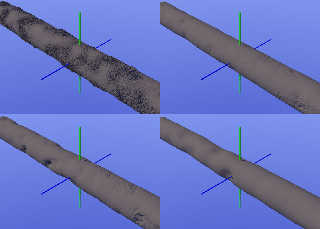|
 |
<---------------------- References. Fourteen previous posts
Function / pattern issues. New inbuilt f_elliptical_sphrswp().
http://news.povray.org/povray.beta-test.binaries/thread/%3C5ee529b9%241%40news.povray.org%3E/
and
Function / pattern issues. Povr supertoroid parametric.
http://news.povray.org/povray.beta-test.binaries/thread/%3C5ee61540%241%40news.povray.org%3E/
Some time ago Bald Eagle asked about implementing normal like dents for
isosurfaces. After implementing a supporting function f_normal(), I've
coded up in SDL a function (inside functions.inc) called F_ndents(). It
uses too the previously implemented inbuilt f_dents() and
f_turbulence(). The latter with the fixed, non-drifting distribution -
internal Turbulence() function.
To set the table, the dents pattern is one of a few which is implemented
differently for normal{} use than it is for *map use. The former
determines and applies a perturbation to the existing surface normal;
the latter returns a single value which can be used with a *map, among
other things.
F_ndents() determines the surface normal of the base isosurface shape
function with f_normal() and perturbs that normal by f_turbulence where
determined by the f_dents() pattern. The perturbed normal is then used
to warp/move the effective x,y and z coordinates.
This function/shape deformation approach has advantages. The
perturbation is only inward or outward relative to the base shape
surface normal. Further, the deformation by perturbed normal coordinates
doesn't ever 'fracture' the function/shape(1).
Functions where only values are used - say f_noise3d() added to the
shape's returned function values - to roughen a surface very often do.
Especially true where values are added to the base shape function - bits
and pieces often end up floating above the surface.
(1) - Yep. Lying a little. If the isosurface gradient setting (or image
resolution) isn't great enough, you can still 'see' fracturing. Further,
the displacements, if violent enough, can turn inside out surface wise.
Attached we have 4 images using the new F_ndents(). The upper left the
dents + turbulence is applied outward relative to the surface normal. In
the other three images showing inward 'dents'. All at various scaling of
f_dents() and f_turbulence(). There is too a normal like pattern value /
bump_size value being changed to set 'dent in/out direction' and depth.
The existing normal {dents} implementation cannot scale 'dents' and
'turbulence' differently and so is most like the lower right corner
result with an ability to scale larger or smaller in total.
IIRC. Upper left image took a couple minute on my i3. The rest 30
seconds or less. One light and radiosity.
I still have in mind F_crumple() and/or F_collision() functions too -
someday.
Aside: Playing with just a scaled f_normal() as an alternative to shape
'value shells' might be interesting too as a well to get more normalize
thicknesses. I've not had time to try this thought as yet.
---
Generally. Other new functions are f_length() and f_normalized(). Also
back tracked and added *map value support to more recently added
functions where supporting *maps could be of use. I'd originally planned
such *map value support for f_eblob() alone.
Bill P.
Post a reply to this message
Attachments:
Download 'f_ndentsstory.jpg' (103 KB)
Preview of image 'f_ndentsstory.jpg'

|
 |




![]()